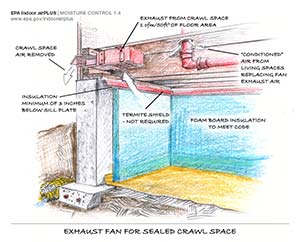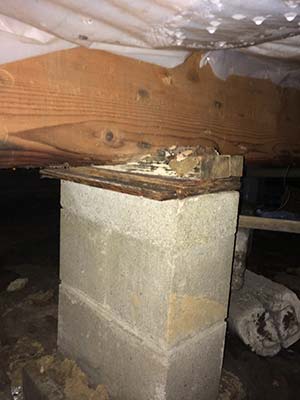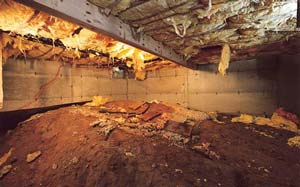Moisture

Water is able to get into a crawl space when it hasn’t been sealed off properly from the outside environment. It can seep in through open vents, up through the ground, or it could get in through the footing.
Problems Caused From the Moisture
Wood Rot
Moisture in this area underneath the home can cause extensive damage. The water will eventually affect the strength and durability of wooden materials, including floor joists and beams that help to support the weight of the home. Decaying wooden supports will also ultimately pose a threat to the overall structural integrity of the home. All of this rotting wood becomes attractive to unwanted critters, as well, including termites, roaches, spiders, snakes, rats, and other various pests.
Mold and Mildew Growth
This water will also contribute to the growth of dangerous mold and mildew. When this fungus grows, it releases spores up and into the air. Eventually, inhabitants of the home will breathe in this contaminated air and it can make them very sick. Mold has been known to cause a variety of serious health problems, including: asthma attacks, respiratory problems, cold/flu-like symptoms, headaches, severe fatigue, skin rashes, and eye irritation.
Poor Indoor Air Quality
Nearly 50% of the air that is breathed in inside of a home first started out in the crawl space. This is why mold growing here can have a serious consequence on the home’s overall indoor air quality. Mold is also a sign of high humidity levels.
Warning Signs of a Wet Crawl Space
Below are some indications that there is water in this space below the home:
- Sagging or un-level areas are felt when walking on the first floor of the home
- Home has a very musty or unpleasant odor
- Critters can be seen entering and exiting the crawl space environment
- Water can be seen pooling up next to the crawl space footing outside the home.
- Inhabitants of the home are experiencing a variety of health problems.
- Home is becoming more expensive to heat and cool throughout the year – rising energy costs.
Importance of Sealing a Crawl Space

When this area of the home is properly sealed off, moisture from outside will not be able to get in to cause problems. Additionally, this will block off excess humidity, and even unwanted insects and pests.
Additionally, with this area sealed off, conditioned air from inside the home won’t be able to leak out. This keeps the home cooler during the summer since hot air can’t get inside, and warmer during the winter since the air from the heater won’t be able to seep out. This will also help the homeowner to save on energy bills throughout each season of the year.
Steps in Crawl Space Encapsulation
Crawl space encapsulation is the process of sealing the area off from the outside environment. It will involve the following.
- Insulating the walls to reduce the transfer of heat into and out of the space.
- Vapor barrier installation to the walls and floors of the area.
- Ventilation will need to be added either through a mechanical exhaust fan, vent, or with conditioned-air supply.
- Floor drains and sump pumps will be installed to prevent flooding below the home in case moisture is ever able to get inside or come up through the ground.
- Perimeter walls to the crawl space will be sealed, and this includes doors, access
Facts About Leaky and Un-Sealed Crawl Spaces
- Vented crawl spaces with dirt floors are typically what is set up under most homes, and this is in accordance with most local building codes around the country – but it isn’t enough to keep moisture out.
- Airborne mold spores and other allergens can pop up from a wet crawl space and pollute the air the inhabitants of the home are breathing.
- Crawl space encapsulation is recommended by most scientists to prevent moisture problems altogether.
- Insulation in a CS can help to lower the homeowner’s energy bills and provide for a much more comfortable living environment.
Find a local crawl space repair contractor in your area to take care of your moisture problems right away before they lead to even more damage.


